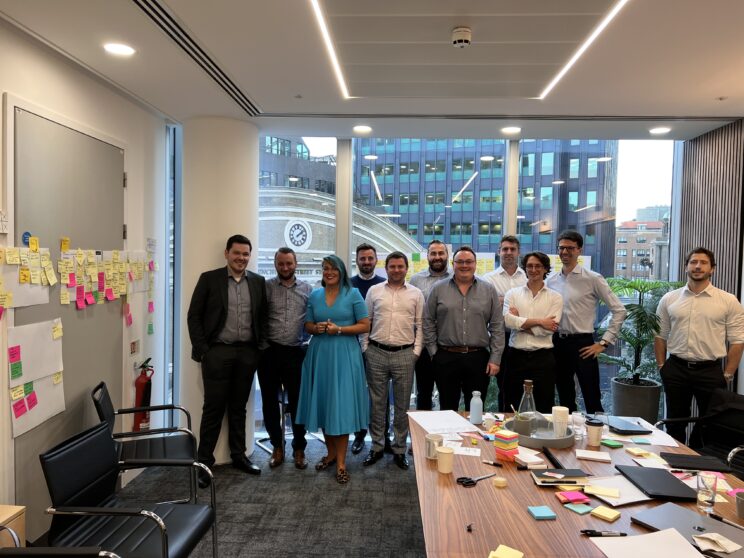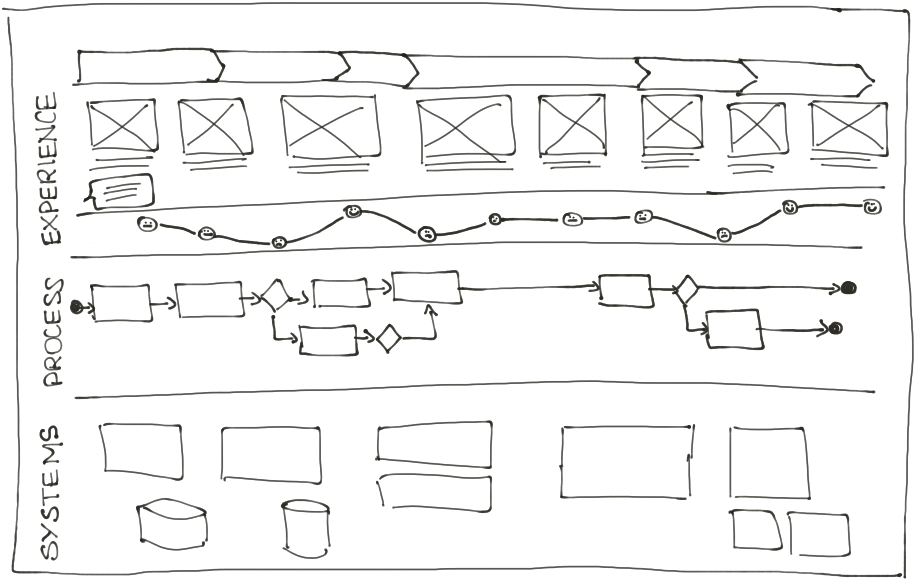Every conversation I have had about work in the past year has mentioned AI. Of course. It is the hot new emerging technology, and the one most likely to truly revolutionise how business is done… as long as some kinks (read: hallucinations) are eliminated from its behaviour.
But… say you are responsible for a company’s operations, and you would like to use AI (or any other tool) to do things faster, cheaper, and with some work, more delightful for your customers…
How do you figure out what you should stick where?
The answer is: a map. So… Service Design.
Well. The Discovery part of it. Mapping out the Service Blueprint of the as-is service.
It is deep, meticulous work. But it can be started in a single day, already gaining insights as to which top-level steps are giving the company trouble. Because you can map it at any level, starting with naming a step “checkout”, to writing up the wording on the second button on the third page of the checkout process. You go as deep as you need to.

(I realised I was the only woman in the room after I saw the photo 🤦♀️).
You can spend one hour, one day, or one month, and you will have mapped some details of a service.
The front-stage customer journey (the story the customer experiences), the supporting backstage business processes (BPML is mandatory for the deeper work here), and the systems, actors, and touchpoints supporting the delivery of the service. Each of those is documented in a swimlane (row) of the service blueprint.
It looks vaguely like this.

It yields a bird’s eye view of the service, and allows you to see, indubitably see, where your service journey is glitching. Loops, backtracks, duplications, waiting times, too many/few messages, manual tasks, emails,… everything becomes visible, and obvious and something you can point to, so you’re not stuck with holding everything in memory and words.
This is a map of symptoms, not a diagnosis (yet)
A Service Blueprint works like a reverse treasure map.
A map of symptoms, not a diagnosis.
The blueprint is not the solution, or even the problem; it is a way to know where to dig so you can find the _real_ problem.
Instead of highlighting treasure it shows you all the glitches, problems, and traps, because you can overlay it with metrics, qualitative feedback, and sentiment analysis insights; evidence. But these are usually the symptoms, not the reasons behind them.
Now you need to learn why they are happening.

By asking “why” (in various ways) at least five times, and having people from all departments involved in the conversation, you can reach the root cause (problem) causing the symptom (pain point) you have documented.
This is the diagnosis phase, and is the most critical one to success.
If you mis-identify the problem, you will solve for the wrong thing and fail.
Innovation… or hammers looking for nails?
Once the problem is identified, it is time to ideate, to innovate, to co-create.
With the whole team of all disciplines in a room, often including actual users, you invent a different experience and new solutions.
Try this
One rudimentary thing you can do, is to have each person represent an accelerator method, and walk through the entire service and its problems, while each “expert” flags how they believe their method might change the experience.

I use 10 Operations Accelerators
Walking through the service to see which of the solutions you have handy might fit a problem is a starting point. It is hammers checking to see if they fit the nails, but it does work. Worth using as a checklist in a first pass.
My classic operations accelerators are here.
- Skip: Remove process steps
- Change process: Use a different process flow
- Change method: Use a different method or channel to do the same thing (2FA with app instead of phone call)
- Automation: RPA or another automation to replace something humans are doing
- Integration: Connect directly to a system to get/put data
- MLp: Predictive modeling (ML models can make recommendations to improve operations or change outcomes, e.g. “you can drill faster in this soil” or “if you offer the customer this discount/device they are likely to stay”
- MLg: Generative AI (AI can help accelerate production tasks, e.g. writing a press release or a product requirements document)
- MLa: Agentic AI (AI takes over part of a workflow)
- Self-serve: Change the service so the customers can self-serve (e.g. calendar booking link instead of “when are you free” email tennis)
- Heuristic improvement: A change in the information design or controls can accelerate the step
Obviously if one is looking to only find opportunities for AI-driven acceleration in their operations, the game is seriously simplified by only using options 6, 7, and 8 in the walkthrough “how might….” activity.
Now you know where to stick your AI 😋
Service Blueprinting is a fundamental discovery activity.
And will be the magic tool through which you find where to stick the AI solution you so badly want to have in your business.
Because while I disapprove of the “hammer looking for a nail” approach, I do approve of a creative matrix.
And with a Service Blueprint where swimlanes contain actors, the Operations Accelerators can be crossed (matrixed) with each role in each step, for some quick contemplation on what that method or technology might unlock for that role in that context. It is a basic, but effective, ideation method.
Some caution is still necessary

Beware, however!
1) Not all new technologies are ready
Air Canada installed a chatbot on their site, and a customer used it to check how one policy worked. The bot gave them an answer that the customer trusted, but was wrong.
And then when Air Canada refused to honour what the chatbot had said was the policy… it went all the way to court… with the Judge ruling that Air Canada was liable for the information their agents give, including chatbots.
2) You risk rolling a turd in glitter
Very often, the hansaplast approach (applying a plaster on one small cut) is only useful to find narrow spots to experiment and innovate in. You might put in a lot of effort, learn, but then see you haven’t solved deeper issues or innovated as broadly as you could have done. The business will often be better served if larger stretches of the experience are explored for deeper transformation of the service (experience, operations, systems), rather than a patchwork of tactical technology plasters.
Mapping and small experiments are a start that anyone can make
The hammer-looking-for-a-nail approach is a decent way to identify areas where the experience is so glitchy as to benefit from an experiment with the preferred new technologies. Bigger corporations may have more to invest in a longer and deeper transformation from the get-go, but for everyone else, a smaller targeted approach, based on a map, is the best place to start.
And if you are lucky, a large step or even whole experience experience, in your service will immediately appear as easily replaceable, and open you a door to deeper innovation.

Well now you know that service design is a great way forward: map your symptoms, identify your problems, and ideate for new solutions. Or just see which of the Operations Accelerators might fix some of your biggest problems.
A map is the best start.
Want to make yours? I am available across most social platforms for a coffee-sized conversation!

